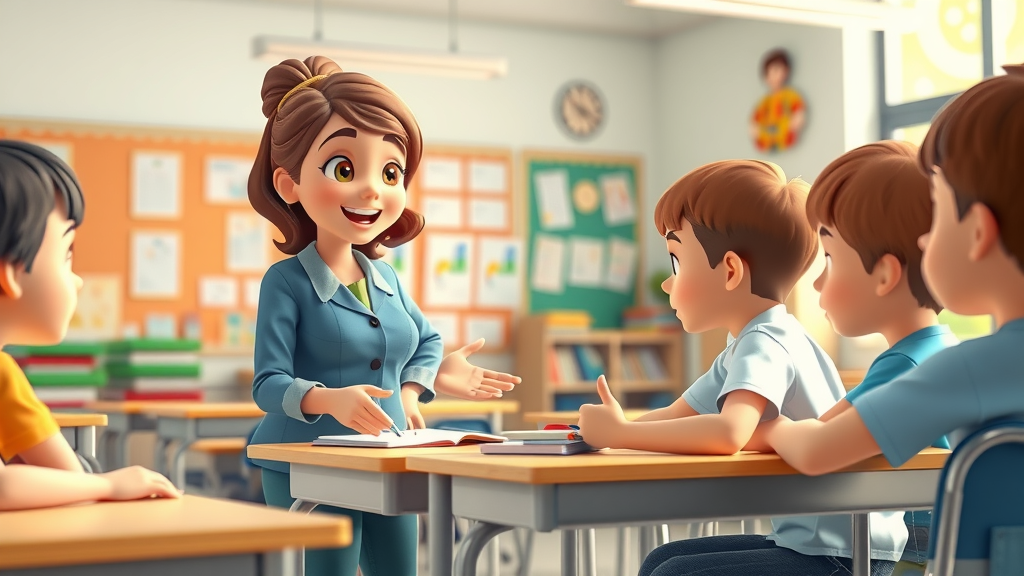Did you know that nearly one in five children will experience bullying in their school years? This alarming statistic means that every parent must be vigilant—empathic support and effective bullying prevention strategies for parents are more essential now than ever to protect their child experience. Protecting your child’s psychological health starts with recognizing the signs, knowing how to intervene, and partnering with schools for a safer environment.

In this comprehensive guide, you’ll learn actionable, expert-approved strategies to help stop bullying before it starts and prevent long-term harm
Why Bullying Prevention Tips for Parents Matter: The Startling Truth Behind Child Experience
Bullying is not just a typical childhood challenge—it’s a significant risk to your child’s mental health and overall well-being. According to research from official government websites and nationally recognized health organizations, bullying can cause lasting emotional and physical health problems.
The child experience of bullying often results in anxiety, depression, decreased academic performance, or even avoidance of school altogether, highlighting the urgent need for bullying prevention. When parents are proactive in learning bullying prevention tips, they can provide children with the psychological safety and resilience needed to overcome or avoid such situations.
Early intervention makes a profound difference. Research suggests that children who are supported by their parents and teachers are more likely to report bullying incidents and recover better from their experiences. The school environment, especially for middle and high school students, can be complex; peer pressure and digital media platforms make the prevention of bullying behavior a shared responsibility for families and school personnel alike.
"One in five children will experience bullying—early intervention and prevention is critical." — National Center for Educational Statistics
Understanding Bullying Behavior: The Impact on Your Child
Understanding how bullying behavior affects children is the first critical step in empowering parents to prevent bullying. Victims of bullying often experience feelings of isolation, shame, and helplessness that can damage self-esteem and interfere with academic and social development.
Even bystanders and children who bully others are at risk for negative mental health outcomes, ranging from increased aggression to higher likelihoods of developing long-term emotional or behavioral issues. For busy school students, these effects can spill over into every aspect of life, affecting friendships, extracurricular involvement, and even their future outlook.
It’s vital to realize that bullying situations occur both in person and online. Social media and digital behavior have amplified the reach and severity of bullying, making it possible for harmful interactions to occur around the clock. By being alert to changes in their child’s mood or behavior, parents can intervene early and stop bullying from escalating. Bullying prevention tips for parents are not just preventative—they are essential tools for safeguarding a child’s mental and emotional well-being both at home and online, addressing bullying behavior in all forms.
Recognizing the emotional impact of bullying is crucial, but it can be equally challenging to know how to support your child if they’re struggling to open up. If you’re unsure how to start this important conversation, you may find these key tips on how to approach your child about therapy especially helpful for building trust and encouraging honest dialogue.
Recognizing Signs When Your Child Is Being Bullied
Many children struggle to talk openly about bullying, often due to fear, embarrassment, or not wanting to worry their parents. This makes it essential for parents to recognize indirect signs that their child is being bullied. These signs frequently appear suddenly and may be easier to notice than you think. When you observe your child’s behavior, look for:
Changes in mood or behavior: Increased withdrawn behavior, sadness, irritability, or anger are early warning indicators.
Unexplained injuries: Frequent bruises or physical complaints, such as headaches or stomach aches, with no clear explanation.
Avoidance of social situations: Reluctance to go to school, participate in activities, or spend time with certain groups of peers.
Declining academic performance: A drop in grades, loss of interest in schoolwork, or repeated absences can suggest ongoing bullying.
By staying alert to these signs, parents can take swift action to prevent bullying and support their child’s recovery from the effects of bullying behavior. Identifying and addressing bullying early often prevents more severe mental health consequences down the road.
How Bullying Behavior Develops in School and Online
Bullying behavior develops in various environments—most notably in the busy halls of middle and high schools, as well as in today’s constantly connected digital space where cyberbullying is prevalent. Peer dynamics in school settings can cause power imbalances, where some students exert dominance over others through words, physical actions, or exclusion. On social media platforms, bullying is masked as jokes, comments, or posts, allowing it to continue beyond the school day and making it harder for school personnel and parents to detect.
Cyberbullying is particularly damaging because it is relentless; there is no safe space or time for a child to unplug. School students may encounter bullying in group chats, through hurtful memes, or by being excluded from online activities. The anonymity of digital behavior and the reach of media platforms can intensify the emotional toll. Vigilance and proactive intervention from both home and school are necessary to prevent bullying and help children navigate these challenging environments.

Essential Bullying Prevention Tips for Parents: Building a Safe Environment
Creating a safe and nurturing environment is the cornerstone of effective bullying prevention at home and in school. Parents play a critical role in setting the tone for respectful interactions, teaching compassion, and providing guidance for navigating difficult situations. The most impactful bullying prevention tips for parents center around building trust and maintaining open communication, while also collaborating with teachers and school personnel to create a united front against bullying. Children gain confidence and resilience when they know adults are engaged and supportive of their well-being.
Empowering your child with the skills to stand up for themselves and others, as well as establishing clear expectations around behavior and digital conduct, can make all the difference in stopping bullying before it starts. When parents prioritize inclusivity and model positive behaviors, children learn to do the same among their peers.
Open Communication: Talking to Your Child About Bullying
The foundation of effective bullying prevention lies in honest, age-appropriate conversations. Regular check-ins with your child open the door to sharing concerns and help reduce the stigma or embarrassment that often comes with admitting to being bullied. Use calm, open-ended questions to encourage your child to talk about their day, friendships, and any situations that make them uncomfortable. Express empathy, listen without judgment, and avoid rushing to solutions; sometimes, the most powerful support is making your child feel heard.
Teach your child the importance of reporting bullying to trusted adults and reassure them that their feelings are valid. By maintaining a safe home environment and modeling assertive but kind communication, parents signal to children that they are not alone in facing bullying situations. Reinforcing these open lines of discussion strengthens a child’s resilience and prepares them for future challenges.
How to Prevent Bullying at Home and in School Environments
Parents can take decisive action to prevent bullying by fostering a culture of respect and cooperation both at home and in school. These actionable steps, grounded in advice from school psychology experts and official gov websites, can help families and educators work together to ensure safe learning spaces:
Set clear family rules about respect: Outline acceptable and unacceptable behaviors. Hold family talks about kindness, responsible digital behavior, and why stopping bullying matters.
Encourage inclusive behaviors: Urge your child to reach out to peers who may seem lonely or left out, promoting friendship and group enrichment instead of exclusion.
Coordinate with teachers and school staff: Build relationships with school personnel so you stay informed and have a support network in place if issues arise.
Monitor online activities: Stay engaged in your child’s digital life, setting boundaries for healthy use of social media and encouraging open dialogue about online concerns.
These everyday practices equip your child with the skills to prevent bullying and contribute to a safer, more respectful environment for all students.

If Your Child is Being Bullied: Steps for Immediate Bullying Prevention
If you discover that your child is being bullied, responding swiftly and supportively is crucial for effective bullying prevention and to protect your child’s well-being. Children who feel their concerns are minimized or dismissed may become more isolated, so it’s crucial to validate their feelings and work together on a plan of action. Responding effectively means communicating empathy, involving school personnel early, and, if necessary, seeking advice from a mental health professional experienced in bullying prevention. Remember, the psychological impact of bullying can be profound, so every supportive step counts.
Empower your child by teaching them assertive responses, helping them identify safe adults to talk to at school, and developing a plan for reporting any future bullying situations. Partner with teachers, counselors, and other parents to make sure the school environment is as safe as possible.
Responding Effectively: What Parents Should Say and Do
Your reaction in the first moments after learning your child is being bullied can shape their recovery. Start by listening attentively without interrupting or minimizing their feelings. Let your child share their story at their own pace, and repeat back what you’ve heard to confirm understanding. Remind them they are not to blame and that you are there to support them unconditionally. Work together to brainstorm practical next steps: Should you contact a teacher? Does the school have a bullying prevention plan? Is working with the school counselor appropriate?
Document the bullying behavior details—dates, times, descriptions, and names of those involved—and inform school officials in writing for a record. Remind your child of the importance of reporting any further incidents. Ultimately, your calm, supportive, and proactive response will help your child regain confidence and trust in their environment, as echoed by expert guidance:
"Listen carefully to your child’s concerns—empathy and support can make all the difference." — Dr. Linda Martinez, child psychologist
How to Work with Schools to Prevent Bullying
Schools are legally and ethically obligated to address bullying—especially when it impacts a child’s safety or disrupts learning. Start by reaching out to teachers, school counselors, and administrative staff to communicate your concerns. Provide clear and documented evidence of the bullying, and ask about the school’s policies and bullying prevention initiatives. Many schools offer anti-bullying programs or peer mediation that can help resolve the situation and create a safer climate for all students.
As you work with the school, request regular updates and stay engaged in the process. Encourage your child to report any further behavior immediately, either to a trusted school adult or through anonymous reporting channels if needed. Some official websites offer resources, reporting tools, and customizable letters to help parents navigate communication with schools. A unified, consistent approach increases the chances of successfully stopping bullying and restoring your child’s sense of safety.
If Your Child is Bullying Others: Addressing Negative Bullying Behavior
Learning that your child is bullying others can be distressing, but it’s vital for parents to respond constructively to address bullying behavior and promote positive change. Many children who bully do so as a reaction to their own emotional struggles, peer pressure, or social environment. Effectively addressing your child’s bullying behavior not only prevents further harm to others but also helps your child develop healthier interpersonal skills. Early intervention can prompt behavioral change and prevent escalation into more severe or persistent issues.
Experts recommend responding with open dialogue, assessment of underlying causes, and firm but compassionate guidance. In partnership with mental health professionals and school staff, you can support your child in making amends and learning new ways to manage emotions and relationships.
Identifying Why Your Child is Bullying and What to Do Next
To effectively prevent bullying, it’s important to understand why your child is bullying others and address the underlying causes of their bullying behavior
Assess possible emotional triggers: Are there recent changes at home or school affecting your child’s self-esteem or sense of security?
Discuss consequences and accountability: Help your child understand the impact of their actions on others, and clearly outline consequences for continued bullying behavior.
Model empathetic behaviors: Consistently demonstrate compassion, active listening, and respectful conflict resolution at home.
If your child continues bullying behavior, consider seeking help from a school counselor or a health professional skilled in child psychology. Their guidance can uncover underlying issues and guide positive change, restoring both your child’s well-being and relationships with peers.
Prevent Bullying: Repairing Relationships and Restoring Trust
Once bullying has been addressed, focus on repairing relationships and restoring your child’s trust within their peer group. This may include apologies or restitution facilitated by a school counselor or mental health professional. Reinforce positive peer interactions and offer praise for progress, big or small, toward more respectful behavior. Repairing relationships helps all children involved—victim, perpetrator, and bystander—recover and thrive.
You can also empower your child by enrolling them in programs that build social-emotional skills, such as empathy, conflict resolution, and communication. The transition from bullying behavior to positive peer relationships is possible when parents, children, and school communities work together.
Situation |
Parent Action |
Prevention Outcome |
|---|---|---|
Child is being bullied |
Communicate, involve school, provide support |
Increased resilience, decreased victimization |
Child is bullying others |
Set clear boundaries, seek counseling |
Behavior correction, restored peer relations |
Witness to bullying |
Encourage reporting, teach advocacy |
Empowered bystanders, safer environment |

Advanced Bullying Prevention Strategies for Parents
For families seeking to go above and beyond with bullying prevention, advanced strategies include leveraging school resources, enrolling children in anti-bullying programs, and closely monitoring their digital lives. These approaches address the evolving nature of bullying, especially as children spend more time online and in increasingly complex social environments. Educators and school psychologists encourage parents to stay informed about the latest research, new prevention tools, and evolving legal responsibilities related to bullying prevention.
Programs that integrate social-emotional learning, peer leadership, and digital citizenship into the curriculum are particularly effective. Open partnerships with school personnel, including administrators, teachers, and counselors, provide a comprehensive safety net for children at risk.
Utilizing School Resources and Anti-Bullying Programs
Schools are valuable partners in bullying prevention, offering resources and programs that complement parental efforts to stop bullying and support children. Ask your child’s school about its anti-bullying policies and the resources available for both prevention and intervention. Many schools offer peer mediation, support groups, and classroom lessons dedicated to respect and conflict resolution. Participating in these programs reinforces what is taught at home and helps children see a consistent message around positive behavior.
Involvement in school clubs, sports, or extracurricular activities can also deter bullying by promoting positive peer connections and boosting self-confidence. Parents are encouraged to attend school meetings, join parent advisory committees, and collaborate with educators to support anti-bullying initiatives. When home and school are aligned, children are less likely to experience or engage in bullying behavior.
Monitoring Social Media and Digital Presence for Bullying Prevention
With cyberbullying on the rise, monitoring your child’s social media and digital presence is vital for bullying prevention and ensuring their safety online. Start by having honest conversations about digital etiquette, respectful posting, and how to safely report cyberbullying. Setting privacy controls, limiting screen time, and conducting regular reviews of your child’s online accounts helps prevent negative digital behavior and build trust.
Encourage your child to come to you with concerns about any activity online that makes them uncomfortable. Explain that their online actions have real-life consequences—whether they are the victim, instigator, or bystander. Use parental controls and collaborate with other parents to keep informed about evolving platforms and new ways children communicate online. Balancing supervision with trust helps keep your child safe on and offline.

People Also Ask: Expert Answers
What are some ways to prevent bullying?
Answer: Parents can prevent bullying by fostering open dialogue, setting expectations, collaborating with educators, and modeling positive behavior.
What are the 6 R's of bullying prevention?
Answer: The 6 R’s are: Recognize, Respond, Report, Reassure, Refer, and Reflect—essential elements for effective bullying prevention.
How can parents help to prevent bullying?
Answer: Parents help by building trust, teaching respect, staying engaged with their child’s social life, and taking prompt action if bullying is suspected.
How to deal with school bullies as a parent?
Answer: Remain calm, gather facts, communicate with school officials, and support your child emotionally—ensuring their psychological safety is key.
Guidance from counselors and educators demonstrating how parents can address and prevent bullying step-by-step, featuring real-life scenarios and practical advice for immediate action in both home and school settings.
Top Bullying Prevention Tips for Parents: Quick Reference List
Model compassion and assertive behavior.
Encourage inclusive peer activities.
Stay alert for warning signs of bullying behavior.
Foster open communication.
Partner with your child’s school.
Promote safe technology usage.

Frequently Asked Questions (FAQs) About Bullying Prevention Tips for Parents
What should I do if my child refuses to talk about bullying?
It’s common for children to withhold details about bullying due to fear or embarrassment. Maintain a routine of gentle, open-ended conversations and reinforce that you’re always available to listen without judgment. Encourage your child with examples or stories, and create safe spaces where they feel comfortable sharing feelings over time. If concerns persist, consult a school counselor or mental health professional for additional support.
What role do school counselors play in bullying prevention?
School counselors are trained to identify, address, and help resolve bullying situations. They offer one-on-one and group counseling, interventions, and support plans for both victims and children who bully. By collaborating with teachers and families, counselors help maintain a safe school environment and serve as a vital resource for parents seeking expert advice and long-term solutions.
How can I teach my child to stand up for others in a safe way?
Teach your child to recognize bullying and encourage them to be a positive bystander—intervening only if it is safe, or instead seeking help from a trusted adult. Model and role-play respectful ways to speak up or report concerns, emphasizing the importance of empathy and collective effort in preventing bullying. Encourage participation in advocacy programs or peer support groups to reinforce these skills.
Key Takeaways: Building Psychological Safety with Bullying Prevention Tips for Parents
Early communication and vigilance are critical for bullying prevention.
Empathy and support empower children to navigate bullying situations.
Partnering with schools creates a united front against bullying behavior.
Conclusion: Empowering Parents with Proven Bullying Prevention Tips
Effective bullying prevention tips for parents are your child’s first and best line of defense. By staying involved, setting clear expectations, and building strong school partnerships, you protect not just your child—but every child. Take action today and ensure a safer tomorrow.
"Bullying prevention tips for parents are more than guidance—they are an essential part of every child’s safety net."
Parenting in today’s world means navigating not only bullying but also the complex emotional landscape that children and teens face every day. If you’re interested in deepening your understanding of how to support your child’s emotional growth and resilience, explore our guide on managing teenager emotions and providing effective support. This resource offers practical strategies for fostering emotional wellness, helping you empower your child to thrive both socially and emotionally. By expanding your toolkit, you’ll be better prepared to guide your child through challenges and celebrate their successes along the way.
Sources
To further enhance your understanding and implementation of bullying prevention strategies, consider exploring the following authoritative resources:
“Engage Parents & Youth”: This resource from StopBullying.gov provides comprehensive insights into the roles parents and youth can play in preventing bullying, emphasizing the importance of collaboration between school staff, parents, and students to create a safer school environment. (stopbullying.gov)
“How to Prevent Bullying”: Also from StopBullying.gov, this guide offers practical advice on helping children understand bullying, maintaining open communication, encouraging participation in activities, and modeling respectful behavior to effectively prevent bullying. (stopbullying.gov)
By delving into these resources, you’ll gain valuable strategies and insights to proactively protect your child from bullying and foster a supportive environment for their well-being.
 Add Row
Add Row  Add
Add 




Write A Comment